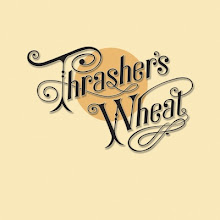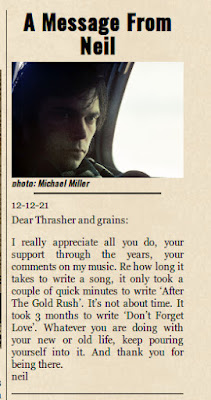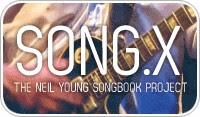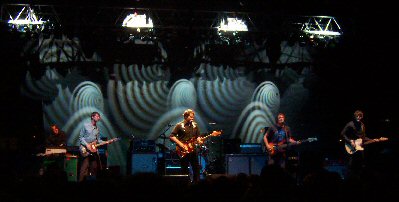Neil Young's "On The Beach": The Images Behind The Album Cover

Recently, we posted on Neil Young's Decade: The Images Behind The Album Cover , which brought on a discussion of the various fonts used on Neil Young's album cover art. (Thanks Mr Tew!)
Neil Young's "On The Beach" album cover is considered to be one of his most creative and intriguing designs in his vast catalog. Is that a rocket ship in the sand? Who drank the can of Coors? What's with the newspaper headline? And the cheesy floral-print matching the tawdry beach-furniture, printed on the INTERIOR of the cover sleeve? How cool was that?!
You've been invited by a guest (with his back to you) to sit at a table on the beach where the ocean vista is obscured from view. We're only permitted to hear the waves roaring but we can't see it.
While it would seem that many of Neil Young's album covers have a rather tossed off feel, that's certainly not the case with the elaborate "On The Beach". For example, the "Living With War" cover is literally stenciled letters on a brown paper bag. In contrast, "On The Beach" album is meticulously designed right down to the inside of the album jacket matching the pattern of the inside of the umbrella on the cover.
"On The Beach" -- the final link of Neil Young's Ditch Trilogy -- is considered by many fans to be one of his best and their most favorite of all Neil Young album covers and artwork. Designed by Gary Burden, photographed by Bob Seideman, and graphic lettering by Rick Griffin, the cover is quite enigmatic with a Cadillac car fin jutting from the sand like a crashed rocket being buried by time. A shoeless Neil stares out into the ocean near a forlorn potted palm. A jaunty yellow beach umbrella matches Neil's jacket. The yellow theme is even continued with a Coors beer can on the table. Inside the album, things become even more crpytic with the album's liner notes. Fans have poured over Rusty Kershaw's strange handwritten note for clues and meaning often to no avail. Apparently, the recording sessions' heavy use of Honey Slides took a toll ... possibly to the creative sides' benefit?

But probably the most significant item on the cover is the newspaper's headline "Senator Buckley Calls for Nixon to Resign". (Young and Nixon have had a bitter and strange relationship over the years. From "Ohio" 's lyrics "Tin soldiers and Nixon's coming" to "Campaigner's" lines "Even Richard Nixon has got soul", Neil has never made a secret of his feelings towards U.S. President Richard Nixon.)
Apple Presentation
(Click photo to enlarge)
In an exclusive interview on Human Highway.org with Gary Burden of R.Twerk & Co., the artist, art director, and designer talks about his journey along the Human Highway. Here's an interesting snippet:
Q: Besides the archives, a favorite Neil album design of yours?(Complete interview on Human Highway.org with Gary Burden.)
Gary Burden: My favorite album cover that I have made, ever, is Neil Young’s “On the Beach.” This cover is loaded with information! From the styles of clothing and objects to the Coors can to the headline of the newspaper of the day of the photo shoot.
My final “gift” to the viewer/consumer was printing the tacky floral designs inside the sleeve.
That one blew the mind of the record company. Not in a good way!
Which brings us to the rather fascinating article ON THE BEACH – Dali, Ballard, Neil Young and Cadillac Ranch | THE END OF BEING by James Reich.
The article brings together a series of unlikely events in 1974 between surrealist artist Salvador Dali, author J. G. Ballard, and musician Neil Young.
If you're unfamiliar with the post-nuclear apocalypse vision of Nevil Shute’s 1958 novel On The Beach (filmed by Stanley Kramer in 1959), than the article will help place Young's album in some perspective.
Ballard's followup novel The Drought was released in paperback in 1974 with David Pelham's cover art of the tail end of a yellow Cadillac part-submerged into the desert.

James Reich analyzes the connections between the surrealism of Dali, Pelham & Griffin:
Uncannily, Pelham’s yellow Cadillac in the sand resurfaces in July 1974 in psychedelic poster artist Rick Griffin’s cover art for Neil Young’s album On The Beach.Check out ON THE BEACH – Dali, Ballard, Neil Young and Cadillac Ranch | THE END OF BEING by James Reich. (Thanks Roel!)
Psychedelic art, even in a generalized sense, is indebted to surrealism, and this image makes specific use of its currency. The image and angle of the Cadillac tail in Griffin’s surreal photograph are strikingly close to Pelham’s illustration, and this is also the work that further binds Pelham’s work to Ballard’s fascination with Dali's The Persistence of Memory.
The melting watches and the dead tree of Dali’s 1931 painting are represented by the forlorn angle of a fringed beach umbrella over the disarray of a cocktail table that Young has abandoned to contemplate oblivion at the limit of the beach. The orange flowers printed on the fabric of the beach furniture, their particular shade and shape allude to Dali’s closed watch, swarmed with ants. The windblown newspaper wrapped about the base of the umbrella (headline calling for the resignation of Richard Nixon which would occur the following month) again marks the end of chronology. Dali’s Catalonian cliffs (absent from Pelham’s image for The Drought) are referenced in the indistinct coastline visible on the right of the record sleeve photograph.
Neil Young’s ragged hair replaces the pubic eyelashes of Dali’s abortive creature on the beach. Alienation and holocaust pervade the album from Young’s solitary abandonment during a radio interview in the title track, to the Manson Family allusions and autogeddon of Revolution Blues: “I got the revolution blues, I see bloody fountains, and ten million dune buggies comin’ down the mountains. Well, I hear that Laurel Canyon is full of famous stars, but I hate them worse than lepers and I’ll kill them in their cars.”

Anyone recall the 1959 film "On The Beach"?
With Gregory Peck, Ava Gardner, Fred Astaire and Tony Perkins in starring roles and direction by Stanley Kramer, the film is based on Nevil Shute's 1957 novel on the aftermath of nuclear war.
Fascinating how the film and album have similar trajectories. On the album, Neil Young sings as if he's devising his exit plan the entire time because he knows the destructive nature of the muse which is anlagous to the theme of the novel and film. And this post apocalyptic world view was presaged by "After The Goldrush" -- but that's another story.
The vibe of the album is bleakly dark ("Burn outs stub their toes on garbage pails/ Waitresses are cryin' in the rain"), resigned ("Though my problems are meaningless/ That don't make 'em go away"), sometimes apocalyptic ("The world is turning/ I hope it don't turn away", and the Manson line: "But I hate them worse than lepers/ And I'll kill them in their cars".) Neil's psyche in music and lyrics reveals a man going through transformation via his art.

ps - Thanks for inspiration Father John Misty: "I think someone should start a website where they do modern-day music writing – the intersectional-virtue-warrior style of music writing – about old albums. With Neil Young's On The Beach it would be, “Oh, great. Another white man singing about how tough it is to be white.” "
pss - sooner or later it all gets surreal... or ... promise of the surREAL ...
Labels: album, art, cover, neil young

































 Human Highway
Human Highway

















 Concert Review of the Moment
Concert Review of the Moment





 This Land is My Land
This Land is My Land

 FREEDOM In A New Year
FREEDOM In A New Year









 *Thanks Neil!*
*Thanks Neil!*




![[EFC Blue Ribbon - Free Speech Online]](http://www.thrasherswheat.org/gifs/free-speech.gif)











 The Unbearable Lightness of Being Neil Young
The Unbearable Lightness of Being Neil Young Pardon My Heart
Pardon My Heart



 "We're The Ones
"We're The Ones  Thanks for Supporting Thrasher's Wheat!
Thanks for Supporting Thrasher's Wheat!




 This blog
This blog 
 (... he didn't kill himself either...)
#AaronDidntKillHimself
(... he didn't kill himself either...)
#AaronDidntKillHimself









































































 Neil Young's Moon Songs
Neil Young's Moon Songs




 Civic Duty Is Not Terrorism
Civic Duty Is Not Terrorism Orwell (and Grandpa) Was Right
Orwell (and Grandpa) Was Right


 What's So Funny About
What's So Funny About 



8 Comments:
Just an observation, but many, or even all of Neil's early album titles seem to be focused on a) time and b) space.
TIME:
Buffalo Springfield Again
Last Time Around
Deja Vu
After The Goldrush
Harvest
Time Fades Away
Tonight's The Night
Long May You Run
Comes A Time
Rust Never Sleeps
PLACE:
EKTIN
On The Beach
Zuma
American Stars N Bars
Good observation Syscrusher.
And how about the Alchemy tour?
From Neil Young's official website Neil Young Times:
A RUST TRILOGY
October 3, 2012
The third episode of A Rust Trilogy, which began with Rust Never Sleeps in 1978, and continued with Weld in 1990, now concludes with Alchemy in 2012. Things have changed, yet they stay the same. Alchemy, like Rust and Weld, finds the boys at another stage of life's journey. Time has taken its toll, yet the spirit seems unstoppable.
+++
Deja vu all over again. Past, present & future.
Incidentally, our take on "alchemy" is that it's a turn on the phrase "rust". Turning either from or to rust -- literally or artistically.
ps - check this:
RNS tour - 1978
Weld tour - 1990/1
Alchemy tour - 2012
22 years between each?
It's all one song...
Except 1978 to 1990 is only 12 years!
@ Roy - hey, what's a decade between friends?! Why do we keep fuckin up???
Reviving an old thread here, but I thought this is kind of interesting. An exact example of the OTB umbrella appears in the last scenes of Smokey and the Bandit. Probably means nothing, but maybe a connection someplace?
https://getyarn.io/yarn-clip/ea53fcd5-b516-40f5-a5d0-76f234d86e76#H1po8ytcdm.copy
I like the way Gary worked the detail on On The Beach, it reflects Neils liking of common or garden objects he used onstage with the Horse; Lamps, Clothes stands (a place to hang ones thigh hi' boots! - the ordinary made extraordinary as a backdrop is a touch of genius imo. Get weird or die trying..🕶️
Post a Comment
<< Home